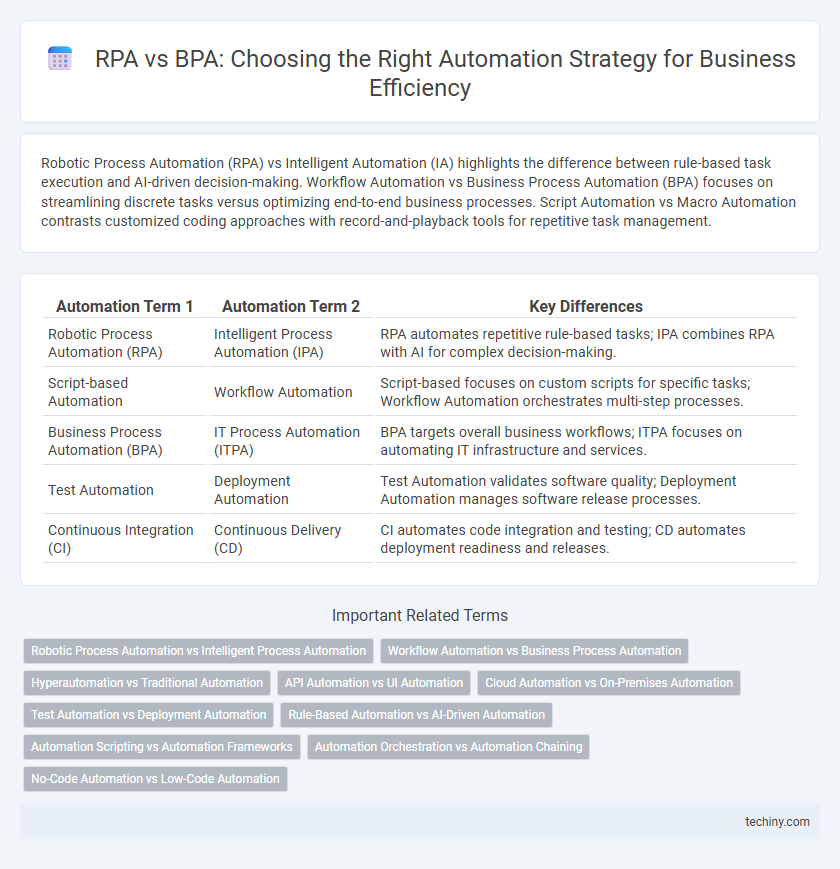Robotic Process Automation (RPA) vs Intelligent Automation (IA) highlights the difference between rule-based task execution and AI-driven decision-making. Workflow Automation vs Business Process Automation (BPA) focuses on streamlining discrete tasks versus optimizing end-to-end business processes. Script Automation vs Macro Automation contrasts customized coding approaches with record-and-playback tools for repetitive task management.
Table of Comparison
| Automation Term 1 | Automation Term 2 | Key Differences |
|---|---|---|
| Robotic Process Automation (RPA) | Intelligent Process Automation (IPA) | RPA automates repetitive rule-based tasks; IPA combines RPA with AI for complex decision-making. |
| Script-based Automation | Workflow Automation | Script-based focuses on custom scripts for specific tasks; Workflow Automation orchestrates multi-step processes. |
| Business Process Automation (BPA) | IT Process Automation (ITPA) | BPA targets overall business workflows; ITPA focuses on automating IT infrastructure and services. |
| Test Automation | Deployment Automation | Test Automation validates software quality; Deployment Automation manages software release processes. |
| Continuous Integration (CI) | Continuous Delivery (CD) | CI automates code integration and testing; CD automates deployment readiness and releases. |
Robotic Process Automation vs Intelligent Process Automation
Robotic Process Automation (RPA) focuses on automating repetitive, rule-based tasks through software bots mimicking human actions, while Intelligent Process Automation (IPA) integrates RPA with Artificial Intelligence technologies like machine learning and natural language processing to handle complex, unstructured data. RPA offers faster deployment and easier scalability for standardized processes, whereas IPA enables cognitive decision-making and adaptability in dynamic workflows. Organizations leverage IPA to enhance process efficiency and accuracy beyond traditional RPA capabilities by incorporating advanced analytics and real-time learning.
Workflow Automation vs Business Process Automation
Workflow Automation focuses on streamlining repetitive tasks within a specific workflow by utilizing software tools like Zapier or Microsoft Power Automate to connect applications and automate data transfer. Business Process Automation (BPA) encompasses a broader scope, integrating various workflows across an organization to optimize complex processes such as order-to-cash or employee onboarding using platforms like IBM BPM or Appian. While Workflow Automation improves efficiency at the task level, BPA drives strategic transformation by aligning automated processes with overall business goals for enhanced productivity and scalability.
Hyperautomation vs Traditional Automation
Hyperautomation integrates advanced technologies like AI, machine learning, and robotic process automation (RPA) to create end-to-end automated workflows, whereas traditional automation typically relies on rule-based, repetitive task execution. Hyperautomation emphasizes scalability and adaptability across complex processes, enabling continuous improvement and real-time analytics, while traditional automation focuses on individual task efficiency with limited integration capabilities. Organizations leveraging hyperautomation achieve higher operational agility and reduced manual intervention compared to traditional automation approaches.
API Automation vs UI Automation
API Automation focuses on testing the backend services by validating API endpoints, data responses, and integration points without the need for a graphical user interface, enabling faster execution and early detection of issues. UI Automation tests the front-end components by simulating user interactions with the application's interface, verifying visual elements, workflows, and end-to-end user experience. API Automation offers higher reliability and speed for regression testing, while UI Automation provides comprehensive validation of user-facing features and usability.
Cloud Automation vs On-Premises Automation
Cloud Automation offers scalable, on-demand resources managed via internet platforms, reducing upfront infrastructure costs and enabling rapid deployment. On-Premises Automation provides greater control over hardware and data security with localized infrastructure but requires significant maintenance and capital investment. The choice between Cloud Automation and On-Premises Automation depends on factors such as scalability needs, compliance requirements, and long-term cost considerations.
Test Automation vs Deployment Automation
Test Automation focuses on automatically executing test cases to validate software functionality and ensure quality, while Deployment Automation manages the automated release and configuration of applications into production environments. Test Automation tools often include Selenium and JUnit that simulate user interactions, whereas Deployment Automation relies on platforms like Jenkins and Ansible to streamline continuous delivery pipelines. Both processes enhance software development efficiency, but they target distinct stages within the DevOps lifecycle.
Rule-Based Automation vs AI-Driven Automation
Rule-Based Automation operates on predefined, explicit rules to execute repetitive tasks, ensuring consistent performance in structured environments. AI-Driven Automation leverages machine learning algorithms to adapt and improve processes dynamically, enabling handling of unstructured data and complex decision-making. Organizations gravitate towards AI-Driven Automation for scalability and flexibility, while Rule-Based Automation suits scenarios demanding predictability and straightforward rule application.
Automation Scripting vs Automation Frameworks
Automation scripting involves writing individual scripts to perform specific repetitive tasks, typically offering quick, targeted solutions for automation needs. Automation frameworks provide a structured environment that integrates guidelines, tools, and best practices to create, maintain, and execute automated tests or processes at scale. Frameworks enhance reusability, scalability, and maintainability, while scripting excels in flexibility and rapid prototyping within automation workflows.
Automation Orchestration vs Automation Chaining
Automation Orchestration integrates multiple automated tasks into a cohesive workflow, enabling centralized control and management across diverse systems and processes. Automation Chaining links individual automation scripts or tasks sequentially to execute in a predetermined order, often within a limited scope. Orchestration offers broader scalability and dynamic decision-making capabilities compared to the linear execution model of automation chaining.
No-Code Automation vs Low-Code Automation
No-Code Automation enables users to build automated workflows without any coding knowledge, using drag-and-drop interfaces designed for business users and citizen developers. Low-Code Automation offers more customization options through minimal coding, appealing to professional developers who need to integrate complex applications and data sources. Both approaches accelerate digital transformation by reducing dependency on IT teams but differ in flexibility and user expertise requirements.
Sure! Here’s a list of niche, specific "term1 vs term2" comparisons in the context of Automation: Infographic

 techiny.com
techiny.com